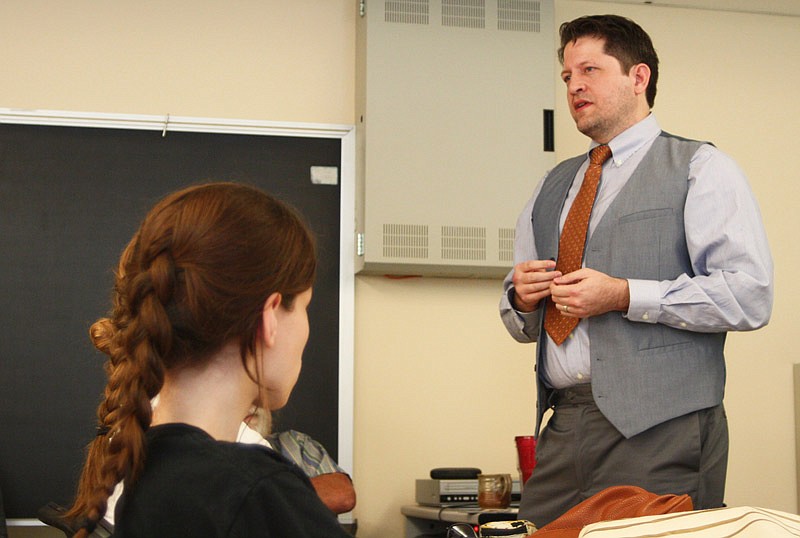Aric Krogstad led a guided discussion on epidemiology and zoonoses - diseases that can pass from animals to humans - at Westminster College's 2016 Hancock Symposium.
Krogstad was the project coordinator at Tulane Primate Center from 2009-12 and has authored multiple papers on topics such as small mammal virology and collagen-induced arthritis. He is a veterinarian, professor and researcher.
The discussion was fairly free-form, with Krogstad firing questions out to the audience and the students responding. The audience seemed engaged and fascinated.
"I really enjoyed the talk," student Rory Dinkins said. "I'm more interested in diseases now than I had been."
Krogstad focused on risk factors for diseases and gave attendees the chance to play epidemiologist, questioning them about how and why certain diseases (such as Ebola and HIV/AIDS) might spread in certain populations.
Krogstad touched briefly on the ethics of quarantine.
"When is quarantine moral?" he asked.
Attendees responded by bringing up Ebola and concluding quarantine was moral when the disease is highly contagious and catching it is likely to result in death.
Krogstad pointed out even the families of someone who is sick may face serious social repercussions when someone goes into quarantine, and social isolation can result.
"When you have an Ebola outbreak, you have people sent into quarantine that might not be helped directly," he added. "It's more about protecting the population."
Krogstad also brought up the controversy around using a limited stock of vaccines to protect medical professionals first, which may prevent the medical infrastructure of a region from being wiped out but may indirectly result in the deaths of unprotected civilians.
Moving on to HIV, he spoke about how epidemiology was used to trace the disease's origin back to primates. Primates like chimpanzees and mangabey are susceptible to simian immunodeficiency viruses (SIV). These viruses can be passed to humans through blood.
"If you're hunting a chimpanzee with a machete and you survive, you're doing well," Krogstad pointed out, meaning that blood transmission is entirely possible in that situation.
Over time, the virus changes through random mutations and "crossover events," where DNA from the host is incorporated into the virus. Virologists can examine the DNA and trace a virus's evolution through time and across hosts.
"One of the biggest misconceptions is that when you get a diseases, you're infected with identical bacteria or viruses," Krogstad said. "Think of a disease as an enormous family with genetically distinct members."
He said it was formerly believed SIV emerged a couple of thousands of years ago, until the disease was discovered in a certain population of primates. What made these primates unique?
They lived on the island of Bioko, near the coast of Cameroon - and tens of thousands of years ago, that island was a peninsula. Since the SIV in those primates is genetically distinct from other strains, it is now believed SIV developed at least 77,000 years ago.
Alongside Ebola and HIV, Krogstad also discussed Zika. He had the audience name off methods of transmission and then brought up ways to control the disease.
"You will run into parasitologists who are big proponents of spraying," he said.
His concern is that spraying puts selective pressure on a population, which allows pesticide-resistant mosquitoes to thrive.
One method of control isn't enough. Rather, Krogstad said, fighting a disease requires many partners, from researchers to security to wildlife pathologists to the general public.
At the end of the session, one of the attendees asked about a local concern: chronic wasting disease. This prion disease affects cervids (deer, elk and moose) in the United States, causing emaciation, lack of coordination and eventual paralysis. It is present in Missouri.
While CWD is not known to be transmissible to humans, the CDC recommends against consuming any meat from an animal with CWD and avoiding eating the brain or spinal cord of the animals it can affect.
Krogstad said there was a "low but real risk" for humans, and advised against eating brains or major nerves of deer.

